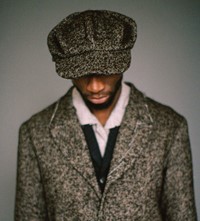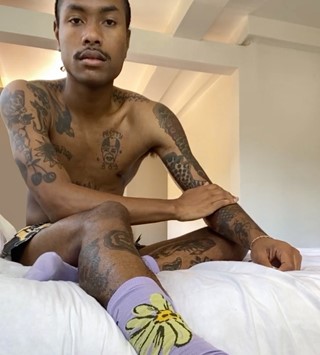Speaking in his own words, designer Daniel Olatunji talks through his Autumn/Winter 2020 Monad collection, which draws on photographs of working-class communities in the North of Britain in the 70s and 80s
- TextJack Moss
“Meticulously imperfect” is how Daniel Olatunji, the designer behind Monad, describes the clothing he creates. He has long been a proponent of ‘slow fashion’ – each piece is entirely individual, and can take months to complete (their component parts can be older still; Olatunji often works with antique or repurposed fabrics). The end result is workwear-influenced tailoring and denim where the beautiful imperfections of craft are left proudly on show, designed to last far beyond the season. Olatunji calls it clothing for life.
Today, on AnotherManmag.com, Olatunji reveals Monad’s Autumn/Winter 2020 collection, captured by Michelle Helena Janssen and Ademide Udoma. Drawing inspiration from photographs of working-class life in England in the 70s and 80s, the collection – including dedicated womenswear for the first time – spans outerwear in antique linen or handwoven Donegal tweeds, tonal untreated wool jumpers, in collaboration with Hollie Ward, and playful floral headscarves, alongside Monad’s signature deconstructed tailoring. “The spirit of the collection is a testament to the frugality of the era as depicted in the photography of John Bulmer and Chris Killip – and similarly my own upbringing in Nigeria,” says Olatunji. Here, speaking in his own words, he tells us more.
“Monad makes meticulously imperfect, tailored garments. Meticulous because they are made by hand, often down to very fibre. It means every Monad piece is individual; it always celebrates craft and process.
“This collection is inspired by images of working-class life in North England in the 70s and 80s; images by John Bulmer and Chris Killip and found images from a recent trip to Bradford. One of the key inspirations came from images of working-class women of the time, their floral aprons and head scarves. I sourced some deadstock floral print viscose and corduroy fabrics from the 80s, which are used as linings and trims throughout the collection sometimes overdyed to give a more subtle finish.
“I wanted to explore ways of spinning tailored clothing with utilitarian sensibilities. The deadstock and surplus wools in the collection were sourced from mills based in the north of England, as well as handwoven Donegal tweeds. [I’ve] also introduced some womenswear pieces, [taking] some of the menswear styles and just tweaking to fit the female form.

“The key pieces are a car coat in French antique linen and washed-silk shirt printed in collaboration with Cameron Short and Janet Tristram of Bonfield-Block Printers. The prints were done by hand using carving gouges and scoops, and a hand-cranked press from 1904. Also, the handknitted pieces in collaboration with Hollie Ward, using black Welsh mountain sheep yarn, a natural untreated yarn that gives you these really beautiful variation in tones.
“Another key piece is the double-breasted coat made from handwoven Donegal tweed by Eddie Doherty, one of a handful of people that still weaves Donegal tweed in the traditional way by hand in his home in Adara, County Donegal.
“The spirit of the collection is a testament to the frugality of the era as depicted in the photography of John Bulmer and Chris Killip – and similarly my own upbringing in Nigeria. One where clothes are not something frivolous but are made to be worn again and again, repaired, treasured.”















